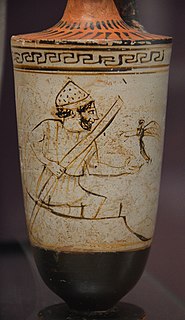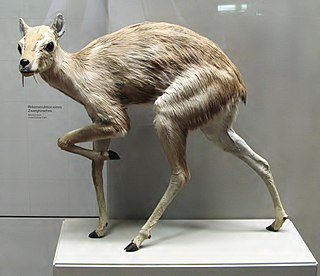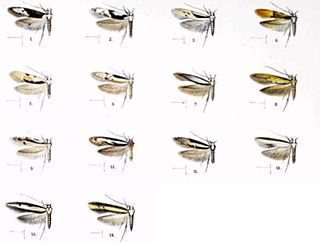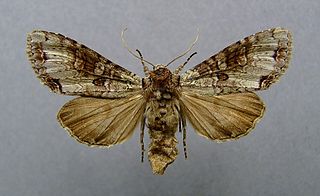
Charon, known as (134340) Pluto I, is the largest of the five known natural satellites of the dwarf planet Pluto. It has a mean radius of 606 km (377 mi). Charon is the sixth-largest known trans-Neptunian object after Pluto, Eris, Haumea, Makemake and Gonggong. It was discovered in 1978 at the United States Naval Observatory in Washington, D.C., using photographic plates taken at the United States Naval Observatory Flagstaff Station (NOFS).

In Greek mythology, Charon or Kharon is a psychopomp, the ferryman of Hades who carries souls of the newly deceased who had received the rites of burial, across the river Styx that divided the world of the living from the world of the dead. A coin to pay Charon for passage, usually an obolus or danake, was sometimes placed in or on the mouth of a dead person. Some authors say that those who could not pay the fee, or those whose bodies were left unburied, had to wander the shores for one hundred years, until they were allowed to cross the river. In the catabasis mytheme, heroes – such as Aeneas, Dionysus, Heracles, Hermes, Odysseus, Orpheus, Pirithous, Psyche, Theseus and Sisyphus – journey to the underworld and return, still alive, conveyed by the boat of Charon.

Moschidae is a family of pecoran even-toed ungulates, characterized by long 'saber teeth' instead of horns, antlers or ossicones, modest size and a lack of facial glands. The fossil record of the family extends back to the late Oligocene, around 28 million years ago. The group was abundant across Eurasia and North America during the Miocene, but afterwards declined to only the extant genus Moschus by the early Pleistocene.
The South African nuclear weapons production facility, having been transferred in 1979 from the Pelindaba nuclear research center to the state-owned Armaments Corporation of South Africa (Armscor), was later developed as the Kentron Circle facility. This facility, built in 1980, and located 20 km (12 mi) west of Pretoria, was subsequently renamed Advena.

Nuphar advena is a species of Nuphar native throughout the eastern United States and in some parts of Canada, such as Nova Scotia. It is similar to the Eurasian species N. lutea, and is treated as a subspecies of it by some botanists, though differing significantly in genetics.

Advena campbelli is a species of air-breathing land snail, a terrestrial pulmonate gastropod mollusk in the family Helicarionidae. This species is endemic to Norfolk Island. It was listed as extinct by the International Union for the Conservation of Nature from 1996. However, the Australian Government lists the species as Critically Endangered, and stated in 2009 that the species' IUCN status was "incorrect and requires updating." A small living population was found in 2020.

Helicarionidae is a family of air-breathing land snails or semi-slugs, terrestrial pulmonate gastropod mollusks in the superfamily Helicarionoidea.

Chelosphargis is an extinct genus of sea turtle from Upper Cretaceous of Alabama. Only one species has been described, Chelosphargis advena.

Mollusca is the second-largest phylum of invertebrate animals after the Arthropoda. The members are known as molluscs or mollusks. Around 85,000 extant species of molluscs are recognized. The number of fossil species is estimated between 60,000 and 100,000 additional species. The proportion of undescribed species is very high. Many taxa remain poorly studied.

Oxycnemis advena is a moth of the family Noctuidae first described by Augustus Radcliffe Grote in 1882. It is found in southwestern North America in the mountains of southern Arizona, eastern Nevada, southern California and southern Baja California.

Hyposmocoma advena is a species of moth of the family Cosmopterigidae. It was first described by Lord Walsingham in 1907. It is endemic to the Hawaiian island of Molokai.

Polia hepatica, the silvery arches, is a moth of the family Noctuidae. The species was first described by Carl Alexander Clerck in 1759. It is found in temperate Europe and east across the Palearctic to Siberia and Korea. It is not present in northernmost Fennoscandia and the southern parts of the Iberian Peninsula, Italy and Greece. It is also absent from Japan.

Ahasverus is a genus of beetles in the family Silvanidae.
Copelatus advena is a species of diving beetle. It is part of the genus Copelatus in the subfamily Copelatinae of the family Dytiscidae. It was described by Sharp in 1882.
Pseudoklossia is a genus in the phylum Apicomplexa. Species in this genus infect marine molluscs, although one species infects in an ascidian worm. The life cycle is heteroxenous.
Porosporidae is a family of parasitic alveolates of the phylum Apicomplexia
Coccotrypes advena is a species in the family Curculionidae, in the order Coleoptera ("beetles"). A common name for Coccotrypes advena is "seed borer". Coccotrypes advena probably originates from Southeast Asia, but is now found in North America.
Trachyphloeosoma advena is a species of broad-nosed weevil in the beetle family Curculionidae.

Calathus advena is a species of ground beetle in the family Carabidae, found in North America. It is sometimes considered a species of the genus Acalathus.












